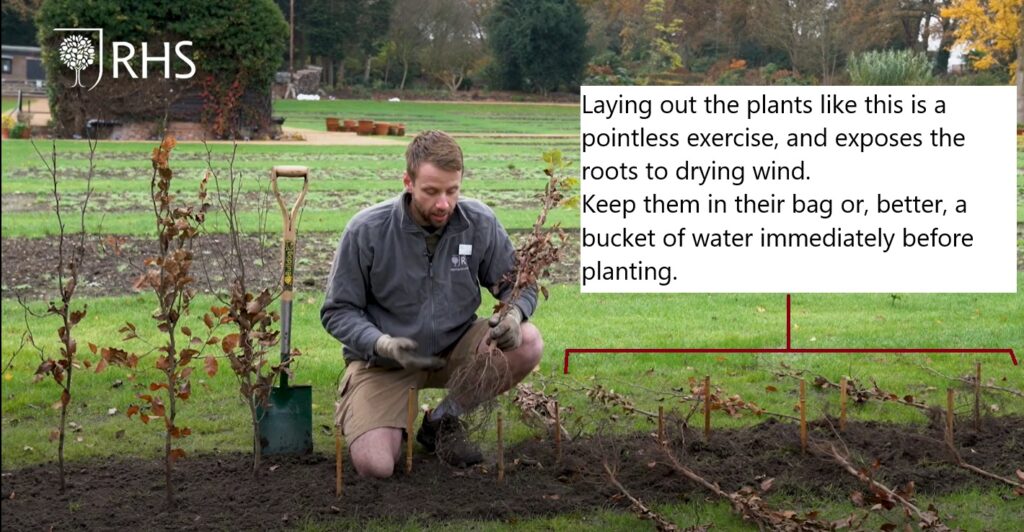There is only one thing I love more than the RHS, and that is sitting with my old feet up, enjoying a hot beverage, and criticising young people from a safe distance while they work hard
Our video on how to plant a formal hedge is, much like me, seriously showing its age, so we’re busy making a new one. In the process, we’re checking out the competition, in the backseat driving style of our Habitat Aid Hedge Planting post.
Four years ago, RHS Wisley’s dashing Alex Hankey, Trials Team Leader at that time, now Alpine Garden Manager, made a video on how to plant a bareroot hedge in your garden, using Beech as an example.
In record time, I single-handedly produced this critique of his work, using the other hand to hold my tea.
Let the backseat driving begin. Alex kicks off by saying:
“So what’s important to bear in mind is that they need to be planted quite soon after their arrival, within two to three days preferably, otherwise the roots will dry out, and you limit the success of the planting.”
Sure, that would be true if you unpacked your plants and left the roots exposed to cold, dry wind.
But as long as you keep the roots in their packaging and store them out of the sun, they will be totally fine for weeks.
The plants are dormant, the weather is cold, and if you are concerned about them drying out all you need to do is stick a hose in the bag and wet the roots – poke holes in the bottom, so the water can drain out.
Alex goes on to say:
“If you’re not going to plant them within the two to three day window that I mentioned, you will have to to heel them in or cover them in compost just to stop the roots drying”
Heeling in is indeed the best way to store bareroot plants if planting will be delayed for a significant period of time, as in several weeks, especially at the tail end of the winter planting season when the weather is warming up.
But as we explain in our how to heel in bareroot trees & hedging article, it’s really not necessary, especially if the delay is a matter of days. The practice of heeling dates back hundreds of years, to when I was a teenager, long before plastic bags and garden hoses had been invented.
Next, Alex has inexplicably laid out each plant next to where it will be planted. Why? I have no idea, he already marked the spots with bamboo canes, which is fair enough. You could also use string.

Alex is opting to dig one little hole at a time, which in my famously humble opinion is cutting a significant corner.
If I were planting this hedge, I would order my minion to dig out the whole trench, thus breaking up the soil nicely, allowing the new roots to spread rapidly, instead of having to fight through potentially compacted soil.
This provides the opportunity to thoroughly remove all the roots of weeds and grass, and if you are improving the soil (which Alex doesn’t need to do here because his topsoil is so nice) you can thoroughly mix it all up, rather than just putting a dob of compost in each little hole.
Astonishingly, Alex doesn’t use any Rootgrow Mycorrhizal Fungi, which is the only soil treatment product ever licenced by the RHS.
He firms the plants in nicely, but there is no water to be seen. I would want the roots to go in the hole sopping wet, and then water them in after firming the soil down. He says you don’t need to water them in at this stage because the plants are dormant, but I disagree with that reasoning on two counts:
- Watering the plants in is to settle the soil, ensuring that air pockets around the roots get filled.
- “Botanical zero” is about 7°C / 45°F. Anytime the soil is warmer than that, there will be some root growth.
Generally speaking, the soil will be colder than 7°C for most of the Winter in Northern and inland areas, but will often rise above it in warmer Western and Southern regions.
However, I will graciously give Alex the benefit of the doubt here and assume that it was going to rain soon after he finished planting, which is just as good.
At the end, Alex suggests staking the plants if you’re in an exposed location, which I agree with, I would only clarify that a bamboo cane is sufficient, rather than a proper tree stake for hedge plants that size.
